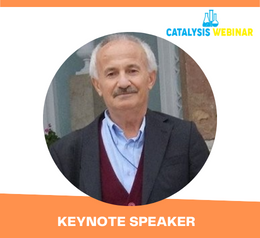Scholars International Webinar on
Catalysis, Chemical Engineering & Technology
THEME: "Contemporary Advances and Innovations in Catalysis and Chemical Engineering Research"
 25-26 Nov 2021
25-26 Nov 2021  Online | Virtual
Online | Virtual THEME: "Contemporary Advances and Innovations in Catalysis and Chemical Engineering Research"
 25-26 Nov 2021
25-26 Nov 2021  Online | Virtual
Online | Virtual 
Firat University, Turkey
Title: Thermomechanical and Thermoresponsive Reactions in the Reversibility of Shape Memory Alloys
Osman Adiguzel graduated from Department of Physics, Ankara University, Turkey in 1974 and received PhD- degree from Dicle University, Diyarbakir-Turkey. He studied at Surrey University, Guildford, UK, as a post doctoral research scientist in 1986-1987, and his studies focused on shape memory alloys. He worked as research assistant, 1975-80, at Dicle University and shifted to Firat University in 1980. He became professor in 1996, and he has already been working as professor. He published over 50 papers in international and national journals; He joined over 100 conferences and symposia in international and national level as participant, invited speaker or keynote speaker with contributions. He served the program chair or conference chair/co-chair in some of these activities. In particular, he joined in last four years (2014 - 2018) over 50 conferences as Speaker, Keynote Speaker and Conference Co-Chair organized by South Asian Institute of Science and Engineering (SAISE), web: http://saise.org/, Science and Engineering Institute (SCIEI), web: http://www.sciei.org, International Association of Computer Science and Information Technology, web: http://www.iacsit.org/, The Academic World Education and Research Center (AWER-Center), web: http://www.awer-center.org/, and other institutes and companies. Dr. Adiguzel served his directorate of Graduate School of Natural and Applied Sciences, Firat University in 1999-2004. He supervised 5 PhD- theses and 3 M.Sc theses. He is also Technical committee member of many conferences. He received a certificate which is being awarded to him and his experimental group in recognition of significant contribution of 2 patterns to the Powder Diffraction File – Release 2000. The ICDD (International Centre for Diffraction Data) also appreciates cooperation of his group and interest in Powder Diffraction File.
Shape memory effect is a peculiar property exhibited
by a series of alloy systems in the ?-phase fields, called shape memory alloys.
This phenomenon is initiated by thermomechanical treatments, by cooling and
deformation; and performed thermally by heating and cooling after thermomechanical
processes. These alloys have dual characteristics called thermoelasticity and
superelasticity, governed by thermal and mechanical reactions, thermal and
stress induced martensitic transformations, and performed thermally and
mechanically.
Thermal induced transformation occurs along with
lattice twinning on cooling and ordered parent phase structures turn into
twinned martensite structures. Twinned martensite structures turn into
detwinned martensite structures by means of stress induced transformation by
deforming plastically in martensitic condition. Strain energy is stored in the
material with deformation and released upon heating, by recovering the original
shape in bulk level, and cycles between original and deformed shapes on heating
and cooling, respectively.
Superelasticity is also a result of stress induced
martensitic transformation and performed mechanically stressing and releasing
in the parent austenite phase region. The materials are stressed just over Austenite
finish temperature, and shape recovery is performed simultaneously upon
releasing the applied stress. The ordered parent phase structures turn into the
detwinned structures by means of stress induced martensitic transformation,
like the deformation step in shape memory. Superelasticity is performed in
non-linear way, unlike normal elastic materials, loading and unloading paths in
stress-strain diagram are different, and hysteresis loop reveals energy
dissipation.
Shape memory effect is performed thermally in a
temperature interval depending on the forward and reverse transformation, on cooling
and heating, respectively, and this behavior is called thermoelasticity. Deformation
at different temperatures in intermediate region between Martensite start and Austenite
finish temperatures exhibits different behavior beyond shape memory effect and
superelasticity, and the materials partially recover original shape. Thermal
induced martensitic transformation occurs with the cooperative movement of
atoms on {110}-type planes of austenite matrix, by means of shear-like
mechanism.
Copper based alloys exhibit this property in
metastable ?-phase region, which has bcc-based structures. Lattice twinning and
lattice invariant shears are not uniform in these alloys, and the ordered
parent phase structures martensitically undergo the non-conventional complex
layered structures on further cooling.
The long-period layered structures can be described by different unit
cells as 3R, 9R or 18R depending on the stacking sequences on the close-packed
planes of the ordered lattice.
In the present contribution, x-ray diffraction and
transmission electron microscopy studies were carried out on two copper based
CuZnAl and CuAlMn alloys. X-ray diffraction profiles and electron diffraction
patterns reveal that both alloys exhibit super lattice reflections inherited
from parent phase due to the displacive character of martensitic
transformation. X-ray diffractograms
taken in a long-time interval show that diffraction angles and intensities of
diffraction peaks change with the aging time at room temperature. This result
reveals a new transformation in displacive manner.